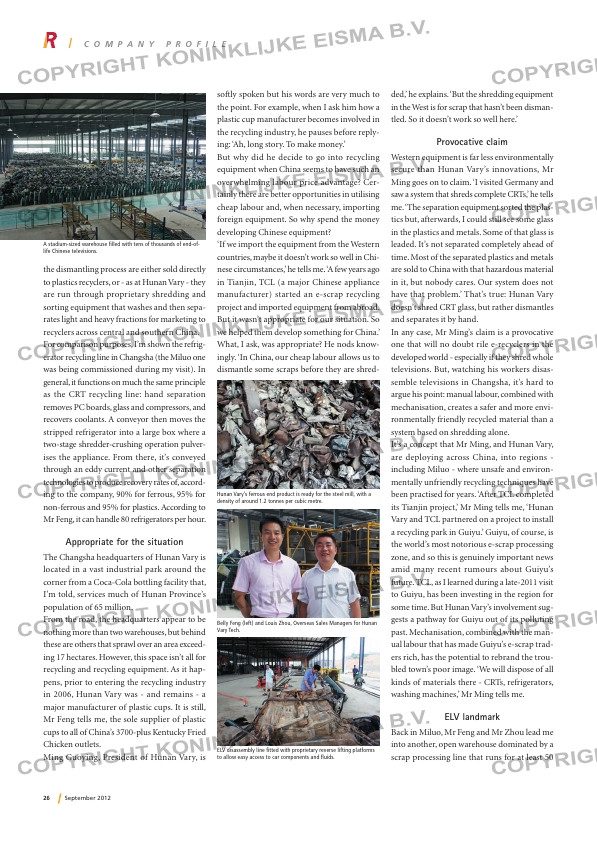Page 26 from: September 2012

26 September 2012
the dismantling process are either sold directly
to plastics recyclers, or – as at Hunan Vary – they
are run through proprietary shredding and
sorting equipment that washes and then sepa-
rates light and heavy fractions for marketing to
recyclers across central and southern China.
For comparison purposes, I’m shown the refrig-
erator recycling line in Changsha (the Miluo one
was being commissioned during my visit). In
general, it functions on much the same principle
as the CRT recycling line: hand separation
removes PC boards, glass and compressors, and
recovers coolants. A conveyor then moves the
stripped refrigerator into a large box where a
two-stage shredder-crushing operation pulver-
ises the appliance. From there, it’s conveyed
through an eddy current and other separation
technologies to produce recovery rates of, accord-
ing to the company, 90% for ferrous, 95% for
non-ferrous and 95% for plastics. According to
Mr Feng, it can handle 80 refrigerators per hour.
Appropriate for the situation
The Changsha headquarters of Hunan Vary is
located in a vast industrial park around the
corner from a Coca-Cola bottling facility that,
I’m told, services much of Hunan Province’s
population of 65 million.
From the road, the headquarters appear to be
nothing more than two warehouses, but behind
these are others that sprawl over an area exceed-
ing 17 hectares. However, this space isn’t all for
recycling and recycling equipment. As it hap-
pens, prior to entering the recycling industry
in 2006, Hunan Vary was – and remains – a
major manufacturer of plastic cups. It is still,
Mr Feng tells me, the sole supplier of plastic
cups to all of China’s 3700-plus Kentucky Fried
Chicken outlets.
Ming Guoying, President of Hunan Vary, is
softly spoken but his words are very much to
the point. For example, when I ask him how a
plastic cup manufacturer becomes involved in
the recycling industry, he pauses before reply-
ing: ‘Ah, long story. To make money.’
But why did he decide to go into recycling
equipment when China seems to have such an
overwhelming labour price advantage? Cer-
tainly there are better opportunities in utilising
cheap labour and, when necessary, importing
foreign equipment. So why spend the money
developing Chinese equipment?
‘If we import the equipment from the Western
countries, maybe it doesn’t work so well in Chi-
nese circumstances,’ he tells me. ‘A few years ago
in Tianjin, TCL (a major Chinese appliance
manufacturer) started an e-scrap recycling
project and imported equipment from abroad.
But it wasn’t appropriate for our situation. So
we helped them develop something for China.’
What, I ask, was appropriate? He nods know-
ingly. ‘In China, our cheap labour allows us to
dismantle some scraps before they are shred-
ded,’ he explains. ‘But the shredding equipment
in the West is for scrap that hasn’t been disman-
tled. So it doesn’t work so well here.’
Provocative claim
Western equipment is far less environmentally
secure than Hunan Vary’s innovations, Mr
Ming goes on to claim. ‘I visited Germany and
saw a system that shreds complete CRTs,’ he tells
me. ‘The separation equipment sorted the plas-
tics but, afterwards, I could still see some glass
in the plastics and metals. Some of that glass is
leaded. It’s not separated completely ahead of
time. Most of the separated plastics and metals
are sold to China with that hazardous material
in it, but nobody cares. Our system does not
have that problem.’ That’s true: Hunan Vary
doesn’t shred CRT glass, but rather dismantles
and separates it by hand.
In any case, Mr Ming’s claim is a provocative
one that will no doubt rile e-recyclers in the
developed world – especially if they shred whole
televisions. But, watching his workers disas-
semble televisions in Changsha, it’s hard to
argue his point: manual labour, combined with
mechanisation, creates a safer and more envi-
ronmentally friendly recycled material than a
system based on shredding alone.
It’s a concept that Mr Ming, and Hunan Vary,
are deploying across China, into regions –
including Miluo – where unsafe and environ-
mentally unfriendly recycling techniques have
been practised for years. ‘After TCL completed
its Tianjin project,’ Mr Ming tells me, ‘Hunan
Vary and TCL partnered on a project to install
a recycling park in Guiyu.’ Guiyu, of course, is
the world’s most notorious e-scrap processing
zone, and so this is genuinely important news
amid many recent rumours about Guiyu’s
future. TCL, as I learned during a late-2011 visit
to Guiyu, has been investing in the region for
some time. But Hunan Vary’s involvement sug-
gests a pathway for Guiyu out of its polluting
past. Mechanisation, combined with the man-
ual labour that has made Guiyu’s e-scrap trad-
ers rich, has the potential to rebrand the trou-
bled town’s poor image. ‘We will dispose of all
kinds of materials there – CRTs, refrigerators,
washing machines,’ Mr Ming tells me.
ELV landmark
Back in Miluo, Mr Feng and Mr Zhou lead me
into another, open warehouse dominated by a
scrap processing line that runs for at least 50
A stadium-sized warehouse filled with tens of thousands of end-of-
life Chinese televisions.
Belly Feng (left) and Louis Zhou, Overseas Sales Managers for Hunan
Vary Tech.
ELV disassembly line fitted with proprietary reverse lifting platforms
to allow easy access to car components and fluids.
Hunan Vary’s ferrous end product is ready for the steel mill, with a
density of around 1.2 tonnes per cubic metre.
C o m p a n y p r o f i l e
RI_7-Company Profile.indd 26 05-09-12 15:25



